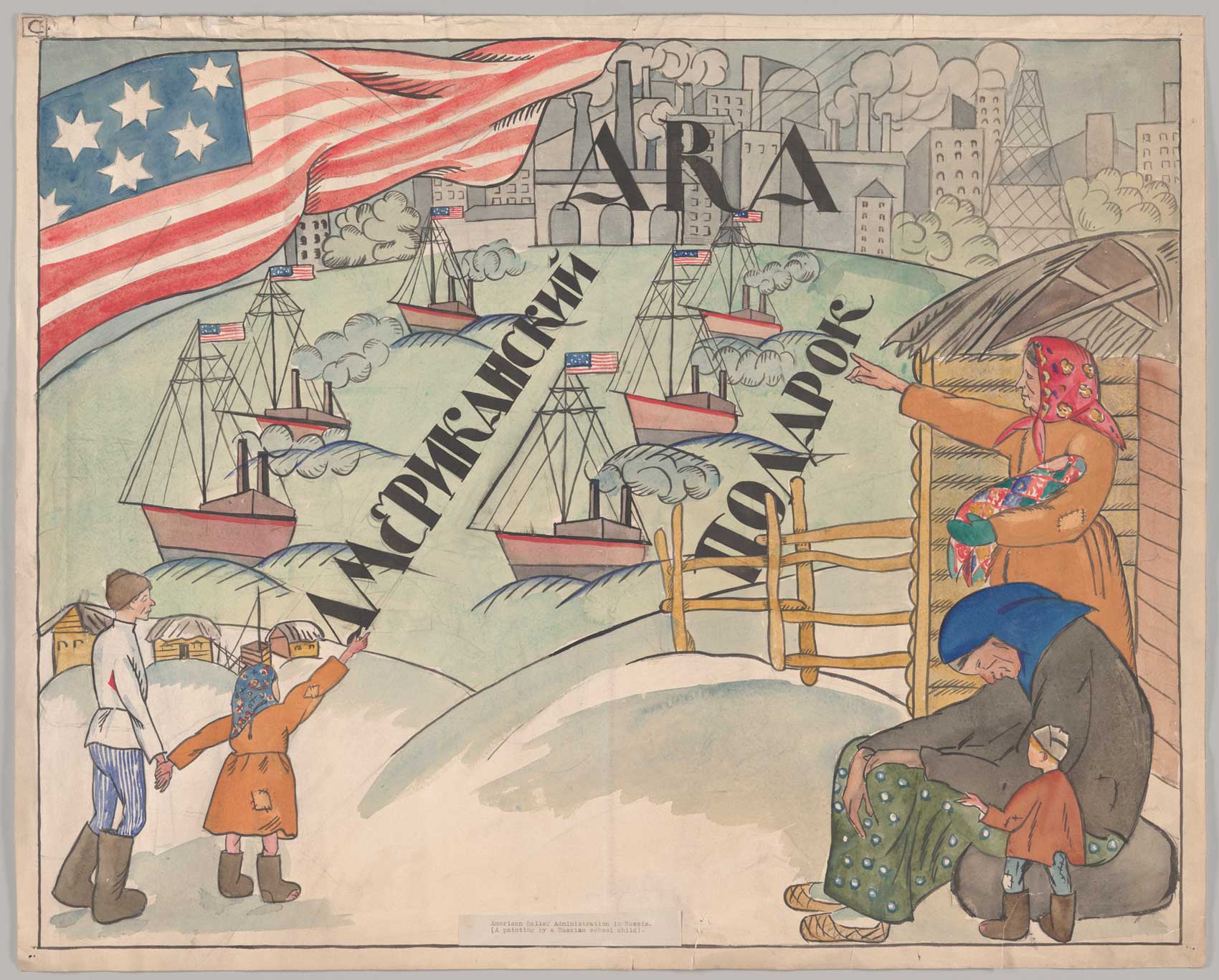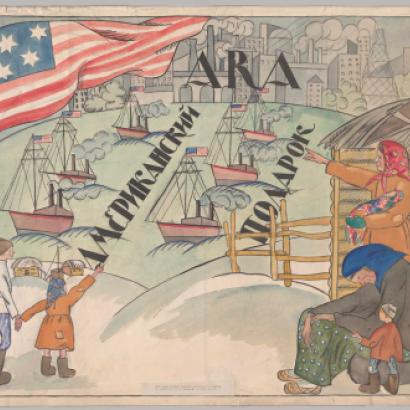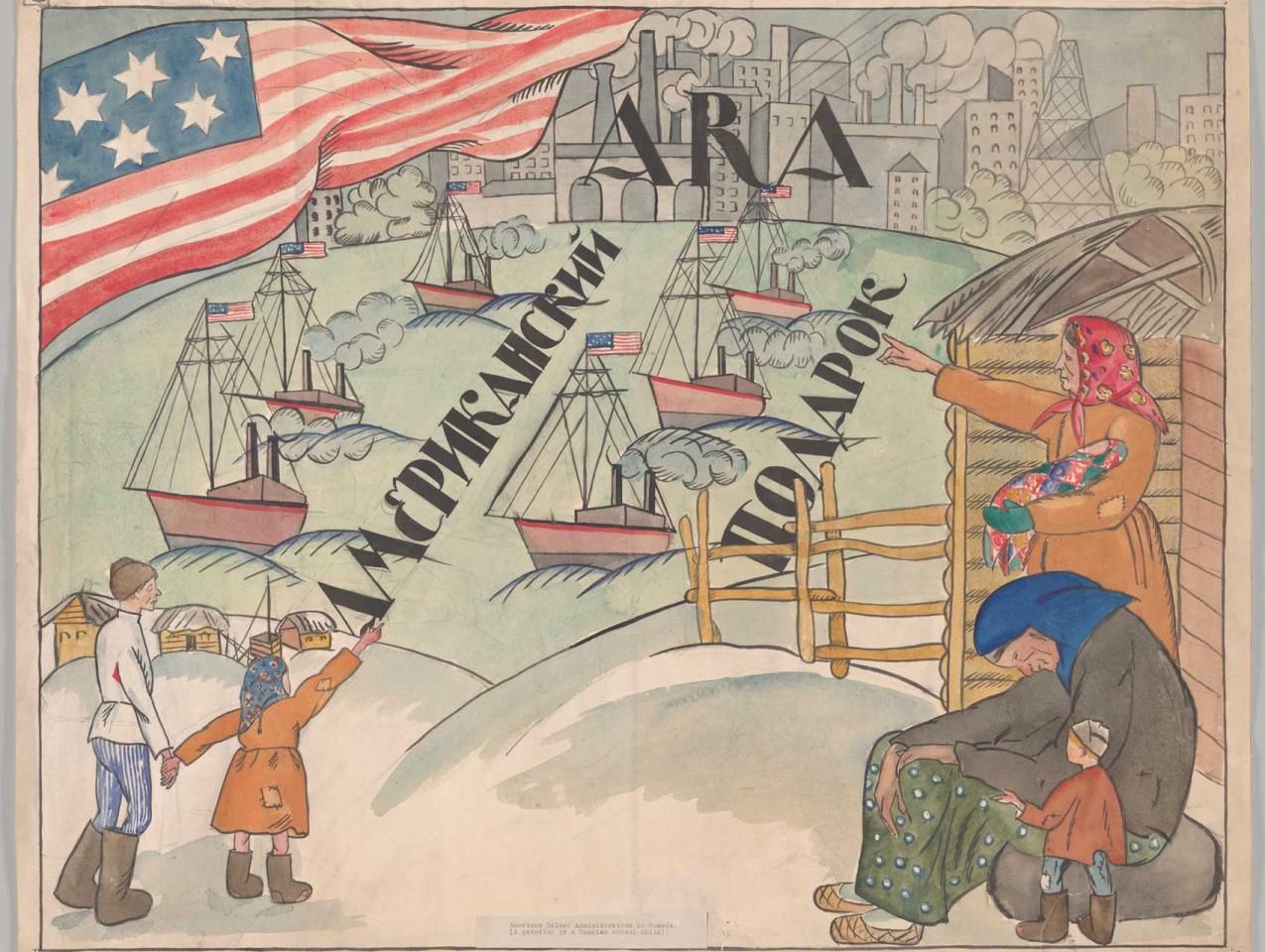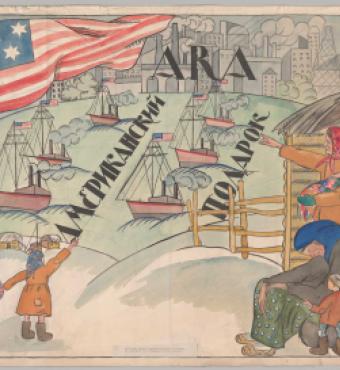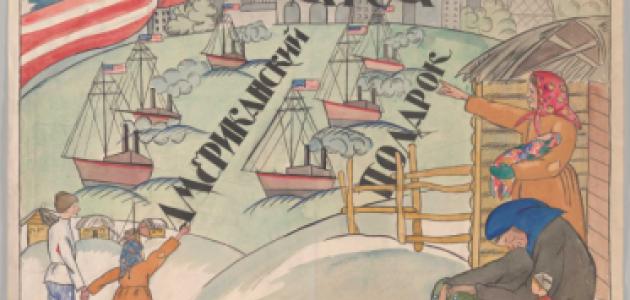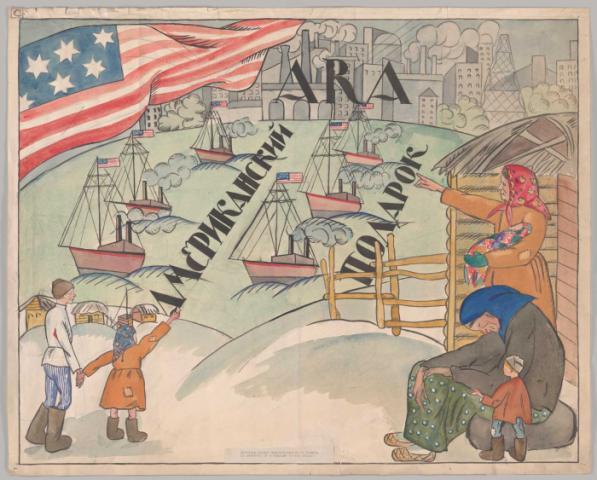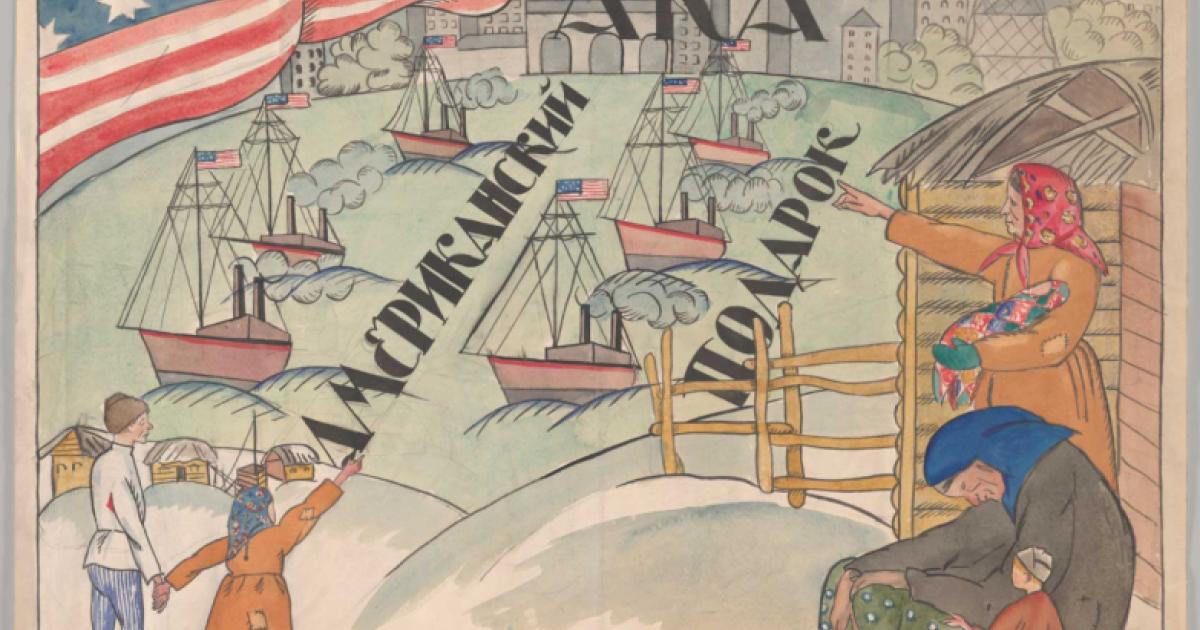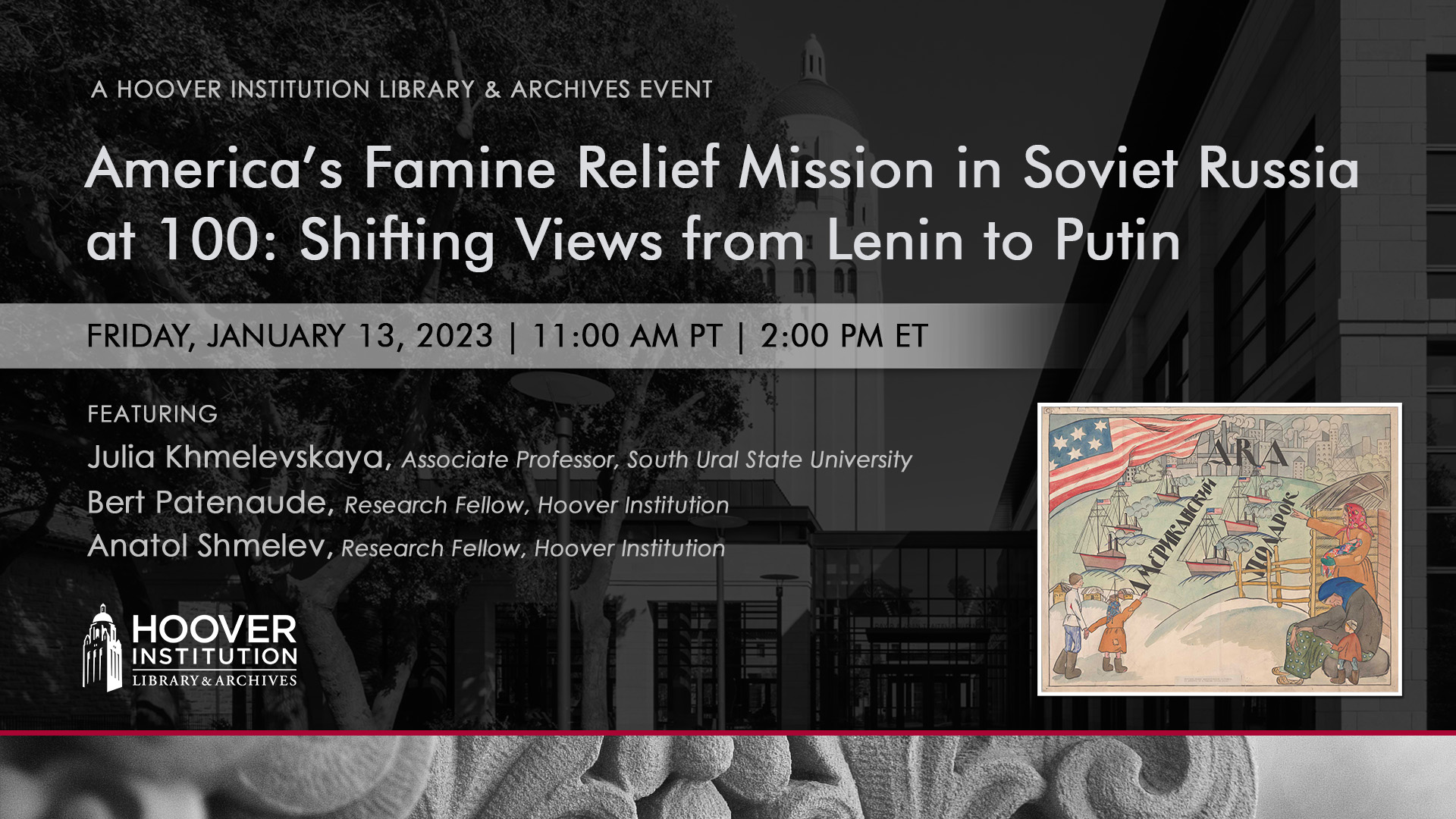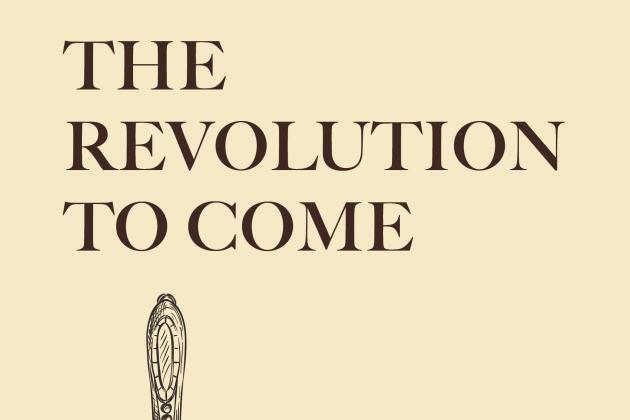

The Hoover Institution Library & Archives presents the Bread + Medicine Speaker Series. This second event is moderated by Anatol Shmelev, research fellow, Robert Conquest Curator of the Russia and Eurasia Collection, Hoover Institution. Presenters will include Julia Khmelevskaia, associate professor, South Ural State University; and Bert Patenaude, research fellow, Hoover Institution. “America’s Famine Relief Mission in Soviet Russia at 100: Shifting Views from Lenin to Putin” is a virtual event which was held on Friday, January 13, 2023, at 11:00 am PT | 2:00 pm ET (75 minutes).
When the American Relief Administration (ARA) departed Soviet Russia in July 1923, it was widely hailed by its millions of beneficiaries, lauded by Soviet officials, and formally thanked in a resolution of the Council of People's Commissars, which forthrightly acknowledged America's contribution to combating the famine of 1921. By the 1930s, however, the Party line instructed that the purpose of Hoover's ARA had been espionage under the cover of philanthropy. The panel explores what became of the ARA's reputation in the USSR under Stalin and his successors, and how it is remembered today in Putin's Russia.
>> Anatol Shmelev: Welcome, everyone, to the second event in the Bread and Medicine speaker series. America's famine relief mission to Soviet Russia at 100, shifting views from Lenin to Putin. This series complements the exhibition now on viewer Tower at Stanford University and its corresponding online exhibition. We will share the link for the online exhibition in the chat at the end of this program.
When the American Relief administration departed Soviet Russia in July 1923, it was widely hailed by its millions of beneficiaries, and lauded by soviet officials, even formally thanked in a resolution of the Council of People's Commissars, which forthrightly acknowledged America's contribution to combating the famine of 1921. But at the same time, there was already a view of the work of the ARA as being espionage under the cover of philanthropy, obviously propelled primarily by the GPU, which had replaced the Cheka, in other words, the Soviet secret police of the time.
And our panel today explores what became of the ARA's reputation in the USSR, under Stalin and his successors, and how it is remembered today in Putin's Russian Federation. Our speakers today, are Julia Khmelwski. Julia Khmelwski is an associate professor in the department of Russian and international history and director of the Center of Cultural History at Southern Ural State University in Chelyabinsk, Russian Federation.
She is the author of numerous publications on Russian American relations and has served as a consultant for the 2022 Russian made documentary film Goled or Famine in English, about the 1921 famine in Soviet Russia. Bert Patenaud, is a research fellow at the Hoover Institution Library and Archives and a lecturer at Stanford University.
His first book, the Big show in the American Relief Administration to Soviet Russia in the famine of 1921, which was published by Stanford University Press in 2002, the 2003 Marshall Schulman Book Prize, and was made into a documentary film for the PBS history series American Experience. He is also the author of Trotsky Downfall of a Revolutionary, published by HarperCollins in 2009, and a wealth of ideas revelations from the Hoover Institution archives, published by Stanford University Press in 2006.
So with this, I am going to hand it off to our speakers who are going to discuss the story of the ARA and how it is remembered today. Thank you very much, Julia Kmilevska, up next.
>> Bert Patenaud: Well, actually, you know what, if I may, I will go first, Anatole, If that's because what I'm going to do, I'm going to be Yulia's setup man.
I'm going to take the story from the end of the ARA mission to the end of the Cold War, and I have some slides to show. So, I'm starting with a poster. It's a poster that was actually produced by a Moscow artist, part of a competition the ARA held in the winter of 1922.
So this would be, February 1922. And by the way, this is the winner of that contest. One of the runners up in the contest is the poster we chose to announce this event. So the reason that the ARA asks for these posters to be produced, and this one says, America to the starving people of Russia.
The reason that Colonel Haskell, the head of the mission in Moscow, wanted posters such as this for wide distribution in Soviet Russia was in order to counteract Soviet propaganda. But also popular misunderstandings, popular misconceptions that basically perceived the ARA as a commercial venture, you know, a business operation, or indicated that it had to be paid for.
It was not a free gift, as the Americans like to insist, or that it was a gift of the American proletariat, which is interesting. This kind of propaganda, to the extent that it came out of soviet official offices or from soviet officials, really took off as ARA, as the ARA was known, gained popularity.
Now, that happens throughout the two year mission. But I think the tensest moment in the mission is at the very beginning, when Herbert Hoover responds to Maxim Gorky's appeal for relief, for help to combat the famine that leads to the negotiations in Riga that eventually get us the Riga agreement.
You can see, looking back at that period, that's when Lenin and his politburo colleagues were the most nervous, they had no idea whether Hoover and his relief workers would stick strictly to food relief. But within a few weeks, they could see that this is what the ARA was doing, they were living up to their word.
So tensions were reduced, but still, this is very awkward for the Soviet government to accommodate these bourgeois philanthropists, right? These American capitalists, come to give food relief and so on. And so what the Soviets try to do, off and on, high and low moments in the next two years, is attempt to gain control over the food, or at least to give the appearance of government control over the relief.
One other element that leads to tension, and I'll come back to it in a few minutes, is tension between the ARA and soviet officials, were the occasional arrests and pretty steady intimidation of the ARA local employees. So the ARA had hired roughly 120,000 Soviet citizens. A lot of these people, I mean, these came as kitchen managers, warehouse people, clerks, I mean, you name it, there was a big team they had to put together to get the job done.
And a lot of the people, especially the ones at the headquarters, especially the ones in the offices were the formerly better off. So, could be considered sort of class enemies. And perhaps some of these people were associated with anti-Bolshevik attitudes in the past or even anti-Bolshevik forces. Those types of people naturally gravitated to the ARA and it was natural the ARA would want to hire them.
So there's highs and lows, this is not a perennial crisis, not a continual, our continuous crisis during the two years. But despite the tensions at the very end of the nearly two year mission, in the summer of 1923, the ARA is about to shut down its mission entirely.
There will be no further contact. The prospect of American investment or American trade. Is nil, there is no official US-Soviet contact, there's no diplomatic relations between the two countries. And all of that lent an air of melancholy to the final banquet. So the farewell dinner that took place in Moscow on July 18, 1923.
So after all of this actual and affected alarm about what Hoover's ulterior motives might be, the officials on hand at this final event seemed to be sincere in lamenting that their government had failed to really do anything with this ARA connection to turn it into a trade relationship or official diplomatic relations.
By the way, in this photo, you go right to left, that's Leonid Krasin with his eyes closed. Soviet diplomat Carl Lander's looking at you, he's got the cigarette in his hand, he was the sort of Sovietminder. That's Colonel Haskell looking very dignified, staring straight at us. The next table, chin on his fist, is Nikolai Zimashko, people's commissar of health.
And that next person to the left, unmistakably, is Carl Roddick, Bolshevik journalist and, yeah, real character. The man standing is Valodin, who's just a facilitator. That's Cyril Quinn leaning in there with the mustache, and he's the deputy director of the mission, and that's Lev Kamenev. And there was somebody sitting just there to the left, let's have a look at who that is, and that would be Maxim Litvinov.
This dinner took place actually inside there in, the former German Embassy, and they came outside for coffee and smokes and photographs, Latvianoff looks like he was shocked by the flashbulb or something. Now, as Anatol said, the Soviet government passed a resolution, this is the Council of People's Commissars, and they sort of wrote it up and had it made up into this, what we call the scroll.
The scroll, because it arrived rolled up and put in a box, and this is what it looked like. It was presented to Colonel Haskell, elaborately decorated, as you can see, and this is the executive branch of the Soviet government. The scroll, by the way, today resides in West Branch, Lowa, at the Herbert Hoover Presidential Library and Museum.
Let's get a closer look, detailed, beautifully done. And the resolution can't read the entire thing says, in part, thanks to the tremendous and entirely disinterested efforts of the ARA, millions of people of all ages were saved from death. And entire villages and even cities survived the terrible disaster that threatened them.
A reminder, at least 6 million people perished in this famine. Further along, it says the Council of People's Commissars considers it a duty to express before the entire world its deepest gratitude to this organization. To its chief, Herbert Hoover, to its representative in Russia, Colonel Haskell, and to all the staff members, and to declare that the people inhabiting the Union of Soviet Socialist Republics will never forget the help rendered to them by the American people through the ARA, seeing in it a pledge of the future friendship of both peoples.
That's what the hope was, to turn this into something. So as the Americans are departing, there's a lot of good feeling at the top, but they do fear for those former staffers, they fear there was gonna be sort of widespread arrests. No doubt scores were settled once the American protectors departed.
But the feared great roundup, the massive arrests, did not take place, didn't materialize. There was a high-profile case in Mintz, couple of people arrested, but really nothing more than that for now. Interestingly, Colonel Haskell, you see him here in 1922, returned to the Soviet Union in 1931. So this is right smack in the middle of the first five-year plan, he is struck by the drama of what's unfolding, the Soviets building, socialism before his eyes.
He notes in a memoir he wrote when he came back that the concept, the cult of the American engineers, so Americanizatzia, Americanization, American technology, Henry Ford, that's as popular as ever. But the memory of the ARA, he noted, was faded, and I'll show you these two quotes, juxtapose these two quotes.
So the first one he wrote in a report to Herbert Hoover at the end of the mission in 1923 to America this is the passing incident of national duty undertaken, finished, and to be quickly forgotten. The story of it will be told lovingly in Russian households for generations.
Through this service, America has not only saved millions of lives but has given impulse to the spiritual and economic recovery of a great nation. And on our own behalf, we have created, in the assurance of goodwill from the Slav races, a great inheritance for our children. Nine years later, it's actually eight, cuz he came back in 31, but look at this quote, President Hoover has little appeal for the Russian man in the street.
The enormous task of his American Relief Administration, which transported hundreds of shiploads of grain from the United States and fed nearly 11 million Russian in the days of the darkest famine of 1921 and 22 scenes almost forgotten. So from that point in the 1930s and Anatole will tell us a little more about this.
This is when, under Stalin, the communist party line begins to instruct that the purpose of Hoover's ARA in Soviet Russia had been espionage under the cover of philanthropy. The ARA did not come up in a formal way at the trial, that is to say, the chief prosecutor at the great Purge trials did not bring it up.
But the record seemed to show that the police interrogators did any, of course, association people had meetings, conversations with foreigners, real or concocted, recent or remote, could be introduced as evidence. And so connection with the ARA, even getting an ARA food package, might cause problems for people. Now, as you know, in those purges, in that terror, the old Bolsheviks, I mean, most of the people around Lenin who made the great October socialist revolution are wiped out.
And literally, and they also then are removed from the Soviethe history books, they become, in other words, blank spots of history. Up until the end of the USSR, the ARA did not become a blank spot, it was mentioned, usually it's ignored. But typically it's sort of mentioned in the context of an ongoing effort of the US government to infiltrate the Soviet Union with spies and wreckers disguised as relief workers.
I mean, in the worst periods of the Cold War, this was really bad stuff. Then comes the death of Stalin, the rise of Khrushchev, which brought soviet leaders to the west to engage in symmetry, other forms of diplomacy. One such encounter took place at the White House in 1959, and it restored the american relief administration mission to the front page of the New York Times, if only for one day.
So this is July 2, 1959. So this is very interesting little moment here. The soviet protagonist in what is a minor subplot is, for all, Kozlov, first deputy premier of the Soviet Union at that time, rising Kremlin Star, comes to Washington in the summer of 1959, as you see there, meets with President Eisenhower.
In the course of the conversation, Kozlov, in rehearsing the usual soviet argument that the United States had long failed to treat the Soviet Union with due respect. Recall the famine of 21 and the shameless behavior of the ARA, which he said had insisted that the soviet government pay in gold for the american relief.
Pulling in on this, so you can see the headline and also the sub headlines there. Now, Kozlov might have gotten away with this, could have gotten away with that. I mean, when it came to details, Ike was no Herbert Hoover, and he may have, except for the recent death of secretary of State John Foster Dulles.
So at a reception that same evening, Dulles successor man named Christian Herder, lay in wait for the deputy premier. And the quote of the Times article is, I wanna straighten you out on one matter, a remark the time says that Herder delivered politely but firmly. Now, why would Christian Herder know anything about this?
Let's go back to Moscow, June, 1922. It's a gathering of the ARA chiefs from New York, from London. There's Haskell, third from the left. There's Quinn, second from the right. And they're basically meeting there to try to figure out if they want to stay for a second year.
Who's the odd man out? It's a tall guy. It's Christian Herder, he's six foot four plus big guy. He is the personal assistant to Herbert Hoover. Here he is later that summer at his desk at the Commerce department. Herbert Hoover, secretary of commerce at this time. So Herder knew something about these things.
Let's flash forward. And here's Herder on the COVID of time, April 27, 1959. So Herder could handle himself just in case. And as the time headline stated, Vice President Nixon was on the theme to back him up. Now, I have to show this. Three weeks later, Nixon would famously mix it up with Khrushchev at a model American kitchen in Moscow.
And maybe he hoped that he could warm up for that contest by sparring for a few rounds with the Kremlin contender, Kozlov. And the food was a gift. That's what the two Americans told Kozlov. No soviet payment was made, none demanded. And according to this Times article, the deputy premier surrendered without a fight.
The quote given here is the question is not one to be discussed. It is not disputed. Interesting. The following month, George Kennan used this little episode as a hook for an article in the New York Times magazine. You see it here. It's July 19, our aid to Russia, a forgotten chapter.
It told most American readers about the ARA and Russia, Soviet Russia, for the first time. So the forgetting part was going on on this end as well. And then Khrushchev put the story back in the newspapers. That September, during a twelve day tour of the US, he came to Hollywood.
You probably know this. There he is on the set of Cancan. You see him? I'm not sure if you can see my cursor, but he's sitting up here. And this is Shirley McLean down here. He had a great time there. He was not in a very good mood this particular day.
He had been informed that contrary to his fervent desire that for security reasons, he would not be allowed to visit Disneyland, this seems to have soured his mood that afternoon. He was furious, actually. And so when he got to lunch in the commissary at 20th Century Fox, and there's the scene of and that is Kirk Douglas Spartacus there.
Someone in the crowd raised the subject of the ARA, which sparked this translated eruption. So here's the quote you referred here to the aid extended to the soviet people after the civil war during the terrible famine of 1921, 22, when Ada, the American relief administration, was set up to aid the starving population, the committee was headed by Herbert Hoover.
We remember that well, and we thank you, but I feel I must raise a but on this score. The but is that our people remember not only the fact that America helped us through, through Ara, and that as a result, thousands of people were saved from starvation in the Volga region.
They also remember that in the hard time after the October Revolution, us troops led by their generals, landed on soviet soil to help the white guards fight our system. Why do I recall all of this? For the simple reason. If you and your allies had not landed troops at that time, we would have made short shrift to the White Guards, and we would have had no civil war, no ruin, no famine, and you wouldn't have had to help the soviet people through Ada, whose work you've just mentioned.
But even so, even in these circumstances, this is Khrushchev, we thank the Americans for the help they gave us. So there's applause but then he finishes with a Khrushchevian flourish. Here's the quote. You see how it is. Ladies and gentlemen, please excuse me for these comments. I assure you that I had planned to make a very short and unemotional speech, but I cannot be silent when someone treads on my pet corn, even if he does so after putting a pad on it.
After that, the episode slips into relative obscurity in the soviet history books. Again, the ARA is still mentioned. Always there's innuendo, not always, but a lot of times innuendo about ulterior motives that the ARA hadn't continues right up into Gorbachev's the Gorbachev eradic. And a favorite example of mine, almost done here, is this diversion under the flag of aid, a 1955 book.
The book's title announces it as an artistic documentary story. It features heroic Cheka operatives foiling the intrigues of the American relief worker imperialists. The ARA men are presented as active agents of military. Intelligence, this might have been a last gasp for this kind of thing until recently. It really becomes a kind of thing of the past.
Gorbachev becomes president, and the Soviet Union collapses. On June 4, 1990, soviet president Mikhail Gorbachev visited Stanford. He delivered a nationally televised speech. You see there, the man on the right is former secretary of state George Shultz, who presented the soviet leader with an original 1921 soviet political poster from the Hoover archives.
It's actually a literacy poster quoting Alexander Pushkin, Long Live the Sun, May the Darkness Be Hidden. Gorbachev, by all accounts, was visibly moved by this. Now, the bottom photo is 1992, a year after the dissolution of the USSR. Former president Gorbachev returned to Stanford. On that occasion came with Raeesa and to the Hoover institution.
And the visit included a tour of an exhibition specially organized for the occasion called the Century of Revolutions, Lenin to Gorbachev, treasures from the Russian and soviet collections. At the exhibition, Gorbachev was drawn to a map of feeding stations, ARA feeding stations in Soviet Russia in 1922, that showed Gorbachev's hometown in southern Russia in the North Caucasus.
And according to those who were present, I wasn't there, he recalled his parents speaking favorably about the good work done by the ARA. But, of course, easy for him to say because he's out of power. And finally, and this is Julia's terrain, but I can pave the way for this.
You start to see the emergence. In the 1990s, there's some pretty healthy literature out there and accurate literature about the ARA coming out of post Soviet Russia. But in the aughts, so the first decade of the new century, you start to see articles like this. The title is gangsters and philanthropists.
So emphasis on the gangsters. And the subtitle is the ARA under the vigilant surveillance of the Chekist, so the Cheka or the secret police. And it's one of these types of documents that gives credibility or takes at face values, secret police files, secret police documents. And, by the way, I should point it out.
You recognize the image in the center there. That's the scroll, which comes with a very different message from the contents of the article. I will stop there. And I think Anatol is going to, is going to add some things to the 1930s period.
>> Anatol Shmelev: Right, thank you very much, Bert.
That was wonderful. So I've introduced our speakers, but I forgot to introduce myself. I'm Anatol Shmelev, I'm the curator for Russia, Ukraine, and Eurasia, by which is meant to really essentially the former Soviet Union. And I have also run into some interesting materials on the ARA, in particular in the archive of the SBU, which is the security service of Ukraine, and they had inherited the archives of the Ukrainian KGB.
So it's quite a rich collection, and we were dealing with them for some time. And so I was able to take a look at what their holdings were, and indeed I found some material on the ARA and I wanted to share that with all of you today. One of the defining aspects of the great terror in the 1930s was the search for foreign spies and foreign agents, and in general, anyone who had ever had any contact with foreigners or with emigres.
But this search for foreign agents allegedly sponsored, supported, or directed by foreign governments predates the great terror by many years. Indeed, it was a prominent feature of the Red Terror in 1918 to 1919, with a so called ambassador's plot supposedly led by allied diplomatic representatives remaining in Soviet Russia, leading to open season on a broad variety of non or anti-Bolshevik figures, many of whom had no direct contact with any allied or foreign governments.
This search for foreign agents either fueled or became a symptom of later attempts by the soviet government to pursue, repress, or simply terrorize substantial segments of the population. In connection with this, the former employees of the ARA, still resident in the USSR, became a prime target of the regime.
Regretfully, we have little direct information about their fates, because the central archives of the KGB or its successor, really the FSB in Moscow, remain largely closed. Only a few lucky researchers have been able to gain access to dossiers relating to their relatives or to prominent individuals repressed by the regime.
Many of those arrested, exiled, and killed by the regime left no descendants who could appeal for information on their ancestors, which is one of the prime legal methods for accessing a file. In most cases, according to the law of the russian federation, files are closed to all except close relatives.
Fortunately, the archives of the SBU, the Ukrainian Security Services that inherited the files of the Ukrainian Soviet socialist Republic's KGB, have been open for some years, although they are now closed, of course, due to the war. And these throw light on the fate of many Ukrainian victims of the soviet regime, in part employees of the ARA who drew the attention of the authorities in the 1920s, as well as later decades.
The predecessors of the KGB, who were known as the Cheka, the GPU, the OGPU, the NKVD, and the MGB, all acronyms, of course, for the soviet secret police, kept extensive records on the ARA and its activities from the beginning of the organization's activity on soviet territory. Lists of US and native employees, reports and notes on suspicious in quotation marks, which means counter revolutionary or espionage activity, accompany materials on the ARA's alleged attempts to recruit spies from among its native staff and the Chekas attempts to place its own informers into the ARA service.
A typical report from this period, which is, say, 1922, 1923, reflects that, I quote, while paying little attention to their direct responsibilities, the misters, which is a typical reference to all Americans, were greatly interested in the location of military units. The SBU archive contains two fat files with 316 and 535 leaves related to the ARA's personnel and activities for the period 1922, 23 alone.
Some of these materials have been published, particularly a set of documents relating to Mennonites and other German colonists in Ukraine, many of whom had resided there since being invited to settle these lands by Catherine the Great. Some of the GPU reports were laughable, such as the insistence that the ARA was engaged in quote, agitation activity instigating people to leave for America.
This at a time when both the soviet government was curtailing immigration and the US government was curtailing immigration. With regard to an American Mennonite aid organization's activity, GPU surveillance reported the following, and I quote, in the village of Bogdanovka in Tokmak Ouyest. One distinctive and mysterious case happened when a villager by the name of Gaida told his fellow villagers that he knows of people serving at the AMP, which is, say, American Mennonite aid who draw up lists of soviet office Workers and send these lists abroad.
The next day, a meal was brought to Gajda from the AMP's cookhouse, although he had never got that before. After taking the meal, Gajda died immediately. Kind of a ridiculous case. I guess it needs to be checked out a bit further, if possible. But it seems like the Mennonite and ARA representatives were suspected of everything from espionage to poisoning anyone who spoke out against them.
But the ARA interested the Soviet security services for many decades after it ceased functioning. The SBU archives hold files covering the fates of its employees into the 1950s. For example, file 687 of font 16 holds almost 300 leaves of documents from 1949 containing information on several former ARA employees that the security services had been monitoring since the 1920s, suspecting them all along of being American spies.
In fact, the GPU, NKVD, KGB, had very complete information on the ARA staff and traced their addresses and employment throughout their careers. One of the SBU files illustrates this with a list of staff and their current addresses, indicating in several cases that one or another person was, quote, in the works, which is to say, in the process of being turned into an informant.
For example, there was a certain Maese Grubnik, born in 1890, who had been employed as an interpreter or translator. In Russian, the words are the same, and remained a resident in Kyiv. And he's given such a notation in the margins of a list of employees in the file.
In another case, Varvara Radzinskaya, arrested in September 1947, was interrogated as to her employment with the ARA some 25 years earlier. She responded that she entered employment on her own initiative in 1922 and worked there for seven months as a graduate of a women's high school in Kyiv.
She knew several foreign languages, French, German, and English, and she felt this knowledge would be useful in working for the ara, which in turn paid her not in money, but in kind, which is to say, in food, clothes, and various household items. Her responsibilities included maintaining lists of people who had received assistance and sending notices to recipients of aid to come and pick up their packages.
Radzinskaya was asked to list all her fellow ARA residents. She maintained contact with him, as well as the american members of the ARA she knew, which led her to confess that she had lived with a certain Hobart brick, while a certain Barney Warley also wanted her to be his lover.
So who knows what's behind that? But the main question on the mind of the colonel of state security conducting the interrogation was, aside from your official work for the ARA, he asked, what other tasks did the Americans assign to you? Her negative response brought no further questions. Another interrogation, this time of Radzinskaya's friend, Maria Yanowsky in April 1938, also had its goal.
The elicitation of names and locations of friends and acquaintances, both within the USSR, as well as those who had left the country during the civil war. Any connections with individuals living abroad, whether foreign citizens or emigres, were pursued with particular interest. This interrogation brought forth a large number of names, mostly academics, because Yanowsky's father in law was a professor.
Yet another ARA employee, Elisaveta Kyminska, was pumped for information in September 1950. The fact that she was a cousin of prominent soviet writer Konstantin Simonov, may have helped her avoid a worse fate than simply being questioned. The notation on the margins of her report is interesting. Although the official's signature is illegible, the text of his marginal note reads, it is necessary in the briefest possible time to acquire assets, which is to say, agents or informants among the former staff of the ARA.
Otherwise, we will not be able to achieve a solution to our mission, end of quote. He insists that at least two assets be acquired within the following month. Regretfully, there is little information on what precise mission was being planned and why the former staff of the ARA, who had worked for the organization nearly 30 years previous, were now so important.
Apparently, the Moscow central headquarters had some operation in mind, perhaps in some way connected or similar to or connected to the doctor's plot that was being hatched at the same time, according to the version recently presented by official FSB historians, the MGB. Well, at that time, that was what the secret police was called.
The MGB's interest in the late 1940s and early 1950s was connected to cold war fears. In particular, that if the USSR were to be included in the Marshall plan, sleeper agents among former ARA personnel would be activated with espionage goals in mind. Yet the doctor's plot association sounds more convincing.
After all, when the article exposing the doctor's plot first appeared in on the 13 January 1953, it explicitly connected the doctors to the joint or Jewish Joint Distribution Committee, which had also been active in Soviet Russia alongside the ARA during the 1920s famine. Therefore, the pursuit, questioning, monitoring, and search for informants among former ARA employees could easily have been the next step to exposing a much broader foreign conspiracy against the USSR.
Perhaps a future opening of the KGB archives will make it possible to prove or disprove this hypothesis. One important fact is clear from all these documents, however, that the ARA members stuck together and continued to maintain personal friendships, correspondence, and mutual visits throughout this time. Many of them, thanks to their knowledge of foreign languages taught at various institutions of higher education, which seems to have presented a particular concern for the soviet security services.
Well, with that, I'll end with my little discoveries in the SBU archive and turn the floor over to Julia Himilevska, who will talk at length about the ARA and its reception today, very interesting subject. So let's turn it over to Julia. Thank you.
>> Julia Khmelwski: Initially, I intended to produce a kind of academic paper, structured and organized.
But then I came to a conclusion that it would be better in current situation to share my own impressions and my own findings about my experiences studying the ARA. I have been doing this for almost 20 years, and my first experience of research, of my work with ARa files was here at Hoover Institution, and it was one of the best experiences in my life.
I have to confess that I live in the Urals. I was born in a small town on the very border between Russia and Kazakhstan. And I knew when I started at school, when I was a student at the university, I knew that there was a famine in the Urals.
But I never heard anything about American help in the Urals. And only in mid-1990s, I got to know that there was American Relief Administration that worked very extensively in the Urals, and more precisely in the Ufa Urals district. That was one of the most. Problematic and most famous stricken in the whole Russia.
Okay, so this is the photo. On the first slide you see the photo, which was made in Chelyabinsk. I guess it was 1923. And I think it was taken at the very end of air re emission in the Urals. And in the center of this photo,you see my main hero, Colonel Bell, and on the right from him is a local official whose last name is Paramonov.
He was head of State Council of Chelyabinsk. On Bell's left hand is Dr. Sloan, American medical doctor who was running a medical program in the district, and the square of that district was about France or maybe Poland. So there were more than five million people famished in that area and it was the area to whom many peoples inhabiting the Urals are very obliged for their help.
As it was put by one of the Bashkir representatives with the ARA, every third Bashkir who would survive in the 1920s of saving his life to the American religion administration. The problem with the Ural region was that it was a remote region, it was multinational, it was multiconfessional.
And the ARA when they came there, they had a lot of interesting cases communicated with the local population and with the local authorities. And Walter Bell, as Verd knows, he deserved a nickname from the locals. He was called idol of the Bashkirs. Bashkirs is one of the Turkic nations, Turkic people, tribes who are living in the Urals and he got to love them.
He got to communicate with them extensively and he was liked very much. And it was almost exclusive case in the whole history of the ARA when American Relief Administration district supervisor managed to establish extreme, exclusively good relations with the local authorities. It was liked both by the population and by the local authorities and even by Chekists.
And here, I have to emphasize it just for interest that one of those Chekists was famous Nahum Eitingon later game spy number one in the Soviet Union. Okay, so when I was a student, I heard about the famine, but I didn't know about the ARA. And when I started to work through the files of the ARA, I found out that the famine in my region was nothing was as bad as in the Volga.
But no one could tell me anything about that famine, not about famine as it is and not about those who helped us to survive. As I got to know later, there were several international missions, the ARA was largest of them. And as everywhere, they would establish local affiliations.
And here, I would like to show you the material, Remains of ARA presence in my region. Not that many of them left, but please, could you put the second picture? Picture number one, sorry. Picture number one was that blue house and this house hosted the headquarters of the ARA in the city of Toretsk in my native town.
Before that, here was located the Toretsk unit, the so-called third unit of Orenburg, Kazakh army, and that particular building was built specially for them. And during the Russian Civil War, it was a house of Red Cossacks and in 1922, in February of 1922, it was given to the ARA.
And until 1923, they were located there, but nobody knows about that. In the city of Toretsk, there is two memorial plates on it. One of them tells us about White Cossacks who belonged to the White Guard during the Russian Civil War. And on another wall, there is another memorial plate which emphasized the service of Red Cossacks.
So two plates of opposite sides during the civil war, but still no memorial plate about the ARA. And, well, I don't think it will appear there in any nearest future because of current political situation in Russia. Bert was telling us about memory of the Aryan perception of the ARA in Soviet time.
In the 90s, after the collapse of the Soviet Union, the situation changed a little bit. But it changed mostly in the academic sphere, because there appeared first academic publications about American Relief Administration and its role during the famine. But popular commemorations of the ARA stayed kinda hidden. They were not expressed openly and the situation is still like this.
In regards of academic studies, we have quite a lot of publications by now about American Relief Administration activities in various regions of Russia, in Crimea, on the Volga, in the Urals, in Petrograd, in Ukraine, in Kazan, Republic of Tatarstan. There is a lot of people who are doing this topic.
But if we speak about public representations, they're still hidden and they are somewhere in family memories. So to sum up, their image, their representation, their memory of the area on official level, was supported mainly in propaganda, mainly in propaganda.A Well, in the 90s, nobody cared about the ARA and promoted.
But later, when Vladimir Putin became the President of Russian Federation, and took the course for making Russia great again, connecting, so to say, the history of new Russia with history of Soviet Russia starting from 2002. There we can see the publications in the media, in the press, which would emphasize again, the subversive activity of the Eyrie and that particular article about gangsters and philanthropists.
It was written, I think in the very end of 1990s. And later on, there were several more publications of that sort. Some of them were written by historians who emphasized their connections, their association with Federal Security Bureau archives. They were very proud of having access to those archives.
It's very difficult to get access there. You have to get a special clearance to get access to work in those places. Once in my life, I tried to get access to former KGB archives. But I have some friends in local Federal Security. By the way, many of them are graduates from historical department of our local university.
And they told me quite openly, if you don't want to have problems with your international passport, please do that. We can provide you with special clearance, but after you won't be able to go abroad. So I decided to quit. I was much interested in the materials of special department, that so called foreign department whose mission was to follow all foreigners in early Soviet Russia.
And those files are still closed. 100 years after the IRA left Russia, those files are still closed. And regular, ordinary researchers from the university without special permission, they cannot get access to those documents. However, some of those documents, due to the mess in the Russian archival services in the early years of Soviet state, some of those documents can be found in civil archives, in state archives.
And I think it's a kind of special feature of Russian archives. The documents about famine and about the Eyrie, they are very scattered, it's very difficult to locate them in the archives. Sometimes they are held under totally misleading titles. And to find certain documents, you have to list 10,000 pages to find something interesting or something unusual.
I have to say that after my work at Hoover archives, and I was there for almost half a year, I didn't found anything particularly new for me in the Russian archives. Probably, except some local memoranda prescribing to the local authorities what to do and what not to do.
Most of the documents that was brought by American Relief Administration from Russia, it's quite enough to understand how they work and how were their relations with local authorities. And when I decided to do this topic and to prepare my publications, I used local archives just because it was required by the Russian journals.
To have citations not only from American archives but from the Russians as well. So I worked extensively in the archives of Moscow, Chelyabinsk the city of Perm, and of course, in the city of Ufa. Chelyabinsk and Ufa are the best, they were too liberal to me. But Perm and Yekaterinburg were the worst by some strange reason.
Maybe because during the famine there was a prescription for the authorities of Perm and Yekaterinburg not to prize American Relief. And generally speaking, the presence of Americans in those cities were undesirable for the Soviet authorities. They were led there, they were allowed to work there for a while, but they were not desired.
And it was a big concern both for NKVD and both for the Soviet government, because they were afraid. Those cities were proletarian cities, and they were afraid of influence of the Eyrie to that proletarian environment. They were afraid of counter revolutionary activity. Can you please put the next slide?
And Batruit, my native town, it was a merchant town before the revolution. It was flourishing, a merchant city, the fair in Troyes that worked all year long unlike, for example, the fair in Nizhny Novgorod or in the city of Irbid. It was working, it was on permanent basis, and it was number three in the Russian Empire.
So it was quite a rich city, with lots of markets and shops and stores and warehouses and lots of, lots of infrastructure around that fair. And if we speak about food supplies before the revolution, and even in the first years of Soviet power, the food was bought and sold in Troyes, not by pounds or pods or stones, but by carts.
One could buy a whole cart of potato or grain for three, five rubles. But after 1920s, Troyes became one of the worst places in the whole Urals, and it was in a desperate condition. And within two years of the most acute stage of famine, Troyes lost one-third of its population.
There were all kinds of horrors there, including cannibalism and corpse eating. The local papers would write very dramatic reports about local cemeteries. And so it was critically important for them to get help from the center. And the problem with Chelyabinsk region and Troyes in particular, was that, until February of 1922 they were not recognized as famished.
They would pay the special tax for help to the famished Volga region. They were sending telegrams and letters to Moscow, asking them to recognize them famished. But their status of famished region was confirmed only at the end of February of 1922. And starting from then there the ARA workers were allowed to enter the town and to settle in that blue house.
Even GPU reports recognized that most of famished population of that city were fed by American Relief Administration. Because local state relief, local affiliation of government relief committee, they didn't have resources at all. So roughly 30 to 75% of those who were recognized as famished introit of those families who went through a certain selection.
They received American food, but not food from Russian sources, from local sources and in spite of their directions and orders from the center. Local newspapers would write Asana to the RA thanking them for their help and for their activity. Although Americans, I mean American Americans, real Americans, visited the city only randomly, once at a time, they would come with inspection.
Because that huge Ural of district had never had more than from five to eight Americans in the headquarter headquarters in Ufa. They had to travel, they had to go to those inspection travels around the region. But they have never stayed in Troetsk for a long time. For a long time so no one of Americans is remembered in Troetsk itself.
But in Chelyabinsk, in the city of Chelyabinsk, suddenly I found an evidence of American presence in truest one cannot anything, absolutely. Absolutely no traces, no memories, no memory plates, nothing, nothing in the local history museum. But in Chileans they have now a new building. When they were checking holdings of or when they were checking storage of that museum that was never on exhibit, they found a very interesting thing.
Please, could you put next slide that used to belong to one of the ARA workers, prominent ARA workers in the Urals district. This is a portrait of Pete Hein Hofstra, who worked in Ufa with Walter Bell. Actually they were kind of competitors to each other, Bell was the chief, and Hofstra he had desire.
He had a plan to organize a special district separate from UWA in Chelyabinsk. And he visited Chelsea many, many times, almost every month because he was kinda having informal relations with the local authorities. And wanted to get their support in organizing separate districts from Ufa. And they had quite a quarrel with Walter Bell and as their colleague Walter William Kelly would put it, Hofstra went out of that fight second best.
So it didn't work, the separate district in Chilevinsk was not organized, was never organized. In spring of 1922, Hofstra contracted typhus and got down with typhus. And he spent several weeks in bed and after that he was sent to a vacation somewhere to Europe and never returned to Chile Evans, but I know that he wanted to stay.
He expressed, at the end of the ARA mission, he expressed his desire to stay in Russia. And to work for the Russian government, to do something for the Russian people and for the Russian government, but he was not allowed. After his return from Berlin, from Europe, he worked in the city of Tsaritsyn on the Volga.
Could you please, next, three slides, one after another. And when local museum workers would go to that storage to check their items that were never on exposition, that were never exhibited in the museum, they found that suitcase. They found that huge suitcase, the travel trunk, and they didn't know that it was connected with the ARA.
As you probably know, Chelyabinsk was the starting point for building Trans-Siberian Railroad at the end of 19th century. And Chelyabinsk is still proud to be a kind of former hub of Trans-Siberian. And that suitcase was put on exhibition about Chilevansk main station and Trans-Siberian, because it's a travel item and it looks very impressive.
And last March, not this year, in March of 2021, in the local museum, it was a centennial of international relief operations in Russia, and centennial of the famine. So they decided to organize a little exhibition about the famine. It was called the third film, and it was based on an album that, again, was found in that storage, the album with photographs of the famine.
I know again from the air files at Hoover. I have never heard about it in Russia and never found any evidence or any reminiscences about that in the Russian documents. But in the historical division of the ARA, I read from them, that there were special albums produced for every famished region to be kept in the local museum.
With dozens and dozens of photographs taken both by the foreign photographer, refers to cameraman and by the, by the Russians. And it is obviously that very album that somehow survived in Chalcedon's local museum and was never on the show, I mean, in public. Of course, the museum workers knew about it, but they had never taken a risk to demonstrate to the society.
And in March of 1921, they did, I decided to start that exhibition, and one of museum workers, who is my former student, he would approach me and ask if I know by any case, who is that Hofstra and why his suitcase is in ChileGus? And I said, okay, I do.
I really know. With that, please, second slide. The last one I know who is that guy? And I sent them some information, and Bert helped me to locate his photo. And now this photo is on exhibit along with the text which accompanies that suitcase. But the very suitcase is still an exhibit about trans Siberian, not about the famine.
So they decided to stay there. That exhibit was not permanent. Some slides, some photographs, I mean, some posters with photographs of the famine were left on permanent exhibition. But most of them, especially those depicting famine horrors, they were taken off in about a month in order not to disturb the public because they were found kind of disturbing and not appropriate for young generation.
This slide, again, it's immaterial evidence of the ARA, but it was preserved not in Russia, but in the US. Here on this picture, you see the statue that was given to the family of Harold Blandy by the Ural workers when Harold Blandy, they were sent to America with his body because he died in Ufa.
He was the only worker of the are who died of typhus on the territory of Soviet Russia. And his body was embalmed, put to a special casket, and sent to Moscow and then to America. And along with the body and with the coffin, they were sent those gifts to his family.
And there was a statue produced by one of the local iron words. Very famous. Actually, it's still famous, and it's still collectible. Okay. And it's still collectible. And please put down. Put number eight. Put number eight. There is a memorial plate on it written by a local, local craftsman honoring Harold Blandy for his work and for his duty he fulfilled in the famine front in Russia.
Do I have still a few minutes to tell a little bit about that movie that was filmed recently? So to sum up, I would like to say that the memory of the ARA is very controversial. From one hand, we can see an inertia from soviet time, efforts to represent it as a subversive organization that kind of wanted to organize a velvet revolution or to overthrow the soviet regime and putting special efforts to that.
And from the other side, when that movie was filmed, that new movie that is still that you can find on YouTube, please, took the next slide. The release of that movie or Twitter triggered a memory flow. People who commenting it was posted on say on it was posted on YouTube less than a month ago.
And now it has almost million point five views, which is very good result. The most important thing for me is nothing that the movie as it is, but the process of memorizing, of remembering and giving tributes to the ARA. Suddenly it appeared that so many people have heard about the ARA from their family members, from their great granddads, from their fathers, from their mothers.
They have photographs, some of them had even items that left from the ARA. Those are not precious of all, but those are just regular cans from condensed milk that were provided to the ARA in the villages so people would preserve them by some reason. And they are ready to share their remembrance.
They are under that movie. We have about 10,000 comments right now, and people are still, they keep commenting, they keep sharing their reminiscences. They are discussing the role of the ARA. They are trying to connected with current situation, with contemporary problems, with food supplies and so on. And another interesting thing I would like to emphasize here, that, you know what famines in Russia happen in imperial time, in old time, they would happen every five, seven years.
And in Soviet Russia, those three main feminists, three main soviet famines of 1920s, of 1930s and late 40s are. It's interesting that people very often they mix those famines. Some people who know something about the famine and about American help, they still mix those famines. And it's interesting that very often the famine of 1920s is not separated from the famine of 1930s.
And it is clearly seen by the commence to the movie that people were expected to see not only the story of 1990s, but the story of 1930s as well. And they are asking why the international help was not continued in 1930s. It is not possible to put in short film all their nations.
But for me it's an interesting phenomenon. And I've been thinking, writing a special article about that in the pillar memory. Now I have material for that. I even don't need to collect it because I have it ready in the comments and they might be very interesting. Conclusions from that.
>> Anatol Shmelev: Well, thank you very much that was a wonderful discussion of the commemoration of the work of the ARA. And it's an unfolding story and I'm sure we'll hear more in the future about how things are remembered, especially this being the 100th anniversary. We have maybe time for just a couple of questions with a couple of really quick answers, one would be what was the role of Armand Hammer in this effort?
Can anybody comment on that?
>> Bert Patenaud: Quick answer, zero.
>> Anatol Shmelev: Zero, okay.
>> Julia Khmelwski: Okay, and also going back to the first- It is connected to the ARA, well, I know that Hoover wanted to get concession from the Bolsheviks for Christum Copper works, but it didn't work. But Armand Hammer doesn't have anything in common with the ARA or with feminine relief at all.
>> Anatol Shmelev: Okay, and then quickly, the title of the YouTube movie, what is that?
>> Julia Khmelwski: It's Golod in Russia, well, it's Russian version, full version in Russian language is there. And the filmmakers have the copy with subtitles, with good English subtitles, if you want to, I can arrange that, it would be sent to for demonstration.
>> Bert Patenaud: We should make clear if we have not, that this film was supposed to be shown in Russia, and I guess last summer, right? Can you just say that briefly, Yulia?
>> Julia Khmelwski: Yes, it was finished, I mean the montage was finished in summer and Russian Ministry of Culture gave the permission, screening permission to it, screening certificate or how would you call it?
I don't know, exact English match, and they started to show it in Moscow, in St. Petersburg, several. And the only public screening was in Ekaterinburg at the end of October, I mean public, it was open for public. All previous demonstrations, previous shows were kind of closed only for those who got special invitations.
And in Yekaterinburg it was demonstrated in their movie hall in the Yeltsin center, and it got very good response from the public. But just two days after the Ministry of Culture revoked that screening certificate, and starting from there, it is not allowed to show publicly. I mean, it can be shown in the museums, in the libraries, in higher educational institutions.
But only there, only for those institutions who have a kind of special license to demonstrate movies like this for educational purposes, not just for commercial or for popularization.
>> Anatol Shmelev: Wonderful, thank you so much, I wanna thank our speakers and I want to thank the audience who participated today.
And I wanted to remind you also about our next event, which is going to be on February 6, 2023, at 04:00 p.m. The politics of soviet famines under Lenin and Stalin, featuring Norman Neymar Kamir Weiner, Bert Patenaude, Jovana Konjevic. So please join us then, and once again, please also visit the exhibition that we have in the Hoover Tower on this whole subject of the ARA's assistance to the famine-stricken population of Soviet Russia.
Thank you once again for joining us and have a wonderful day.
ABOUT THE SPEAKERS

Julia Khmelevskaya is associate professor in the Department of Russian and International History and director of the Center of Cultural History at South Ural State University in Chelyabinsk, Russia. She is the author of numerous publications on Russian-American relations and served as a consultant for the 2022 Russian-made documentary film Golod (Famine), about the 1921 famine in Soviet Russia.

Bertrand M. Patenaude is a research fellow at the Hoover Institution Library & Archives and a lecturer at Stanford University. His first book, The Big Show in Bololand: The American Relief Expedition to Soviet Russia in the Famine of 1921 (Stanford University Press, 2002) won the 2003 Marshall Shulman Book Prize and was made into a documentary film for the PBS history series American Experience. He is also the author of Trotsky: Downfall of a Revolutionary (HarperCollins, 2009) and A Wealth of Ideas: Revelations from the Hoover Institution Archives (Stanford University Press, 2006).
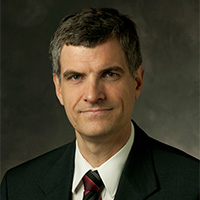
Anatol Shmelev is a research fellow at the Hoover Institution, Robert Conquest Curator of the Russia and Eurasia Collection at Hoover’s Library & Archives, and the project archivist for its Radio Free Europe/Radio Liberty Collection. Shmelev’s expertise is in twentieth-century Russian history, specializing in the Russian Civil War. As curator, he is principally responsible for acquiring archival materials relating to Russia, the Soviet Union, and the independent states that emerged from the USSR after 1991.
ABOUT THE SERIES
The Bread + Medicine Speaker Series highlights conversations with historians of Russia and Ukraine and leading experts on famine and humanitarianism. It is presented in conjunction with the exhibition Bread + Medicine: Saving Lives in a Time of Famine devoted to the American famine relief mission to Soviet Russia in 1921–1923.



